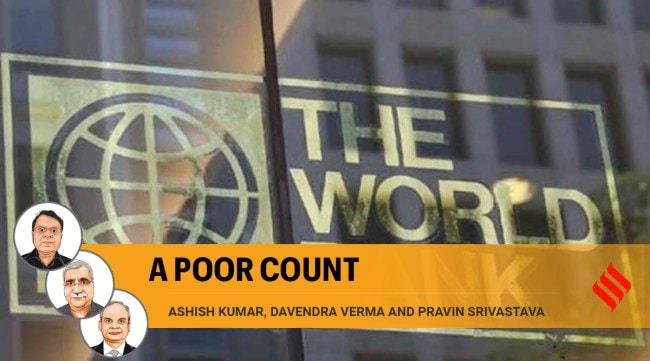Opinion NSS, CMIE are surveys not comparable. Studies should not relate them
The measurement of poverty at the national level does not serve any policy purpose. One has to go down to the state, district, block and village level to identify pockets of poverty to develop and deliver special programmes needed in each case.
 Recently, policy advisors and researchers at the IMF and World Bank have also attempted to estimate headcount ratios under various assumptions. (File photo)
Recently, policy advisors and researchers at the IMF and World Bank have also attempted to estimate headcount ratios under various assumptions. (File photo) Incomplete data or the absence of data itself sets the ball rolling for economists to bring out their macroeconomic models to estimate sensational, eye-catching results, whether it be Covid-19-related deaths or the impact of the pandemic on the vulnerable population. Some economists have argued that the pandemic has directly impacted informal workers and those employed in smaller establishments by pushing them into poverty. Poverty estimation through the consumption approach has its challenges. Some researchers have been attempting to arrive at poverty estimates based on ancillary data available from the government or from other small sample studies.
Recently, policy advisors and researchers at the IMF and World Bank have also attempted to estimate headcount ratios under various assumptions. The huge differences in the headcount ratios between the two studies only add to the confusion in the already complicated measurement issues of poverty in India.
The IMF has carried out the exercise using adjustments for private final consumption expenditure from the National Accounts Statistics and also using the expenditure incurred by the government under the public distribution system. The World Bank has tried to estimate headcount ratios using CMIE data from the consumer pyramids household survey from 2015 to 2019, relating it with the NSS consumer expenditure data from 2011 and data from other sources like the National Family Health Survey, the Periodic Labour Force Survey, the Situation assessment of Agriculture Households, and the All India Debt and Investment Survey. This exercise appears not to follow the basic principles of statistics.
In fact, a lot of econometric tweaking has probably been carried out in an effort to relate the divergent data sets of NSS with CMIE. It may be noted that India uses the NSS consumption expenditure survey for the measurement of poverty and the results from it, carried out in 2017, are not available due to quality issues in the data collected.
The World Bank paper appears to be based on unrealistic and unviable assumptions. First, the sample design of the NSS and CMIE surveys are different. The NSS adopts multistage stratified sampling whereas CMIE uses rotational sampling. Further, CPHS households have unequal sampling probabilities as households on the main streets have a higher likelihood of selection. Even the basic definition of the household is different in the two surveys. Unlike the NSS, the CPHS does not conduct a listing exercise and instead uses projections of households and population growth to construct sampling weights. It has been stated by various scholars that the NSS adequately captures information from the households at the lower end of consumption distribution but inadequately for those at the upper end. However, a lot of doubts have been raised about CMIE data in terms of its representativeness.
Second, NSS collects information on more than 345 unique items to arrive at consumption expenditure estimates whereas CMIE does so through 114 items. While NSS expenditure is based on a recall period of 30 days for food items and others over 365 days, the CPHS consumption expenditure is based on a recall period of the last four months. The attempt to make a comparison by using subgroups of expenditure like food, non-food, and durables may also not be of great help since errors in data collection from the two sources will not necessarily cancel out, but may be additive due to different sets of items.
Third, there is a time difference between the data used from the NSS survey, which is for the year 2011, and the CMIE survey from 2015 to 2019. This lack of comparable years for the development of the model has introduced another error.
Fourth, the change of weights in the CMIE survey at the household level using NFHS and other surveys may not correctly reflect the weighting pattern since the changes in consumption expenditure for a long period can bring out required demographic and other changes.
Truly speaking, the measurement of poverty at the national level does not serve any policy purpose. One has to go down to the state, district, block and village level to identify pockets of poverty to develop and deliver special programmes needed in each case. India already has a measurement of multi-dimensional poverty that gives a better understanding of deprivation. Another initiative is the aspirational districts programme, which is being extended to the block level and provides the direction and location where specific interventions are required.
If at all the World Bank wants to estimate the poverty in India, it should use only the CMIE data which is available from 2015 onwards and measure changes in the poverty ratios, given the structural limitations of the survey. Alternatively, one can wait for the results of the survey that will be undertaken by the National Statistical Office between July 2022 and June 2023. The results are likely to be available a year or so after the completion of the survey.
Kumar is Senior Fellow NITI Aayog, Verma is former DG MOSPI, and Srivastava is former Secretary MOSPI







